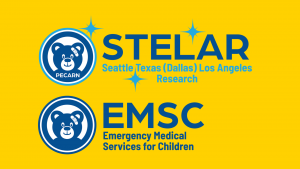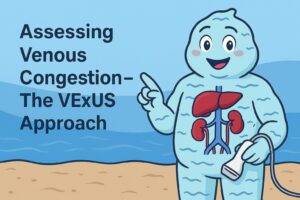Author: Anna Waller, MD (EM Resident Physician, San Antonio, TX) // Edited by: Alex Koyfman, MD (@EMHighAK) and Brit Long, MD (@long_brit)
Case
A 67-year-old male presents to the emergency department (ED) with 1 day of constant, severe, upper abdominal pain that has not been relieved by antacids or rest. He has a history of CAD and diabetes and takes a daily aspirin and metformin at home. He denies previous surgeries. He denies smoking or regular alcohol use and has no medication allergies.
His initial vital signs: BP 102/62, HR 90, RR 22, SPO2 99% on RA, D-stick 142, T 98.6 orally.
Exam reveals epigastric tenderness without guarding or rebound.
Focused Questions:
What can cause pancreatitis? What is the pathophysiology?
How does it present?
What are the diagnostic criteria for pancreatitis?
Should you use amylase? What tests should you order?
Should you get a CT scan? What other imaging is necessary?
Etiology and Pathophysiology
Pancreatitis is the result of an inflammatory process within the pancreas, which possesses roles within the exocrine and endocrine systems. Gallstones are the most common and best understood cause of pancreatitis. Most studies estimate that gallstones are the culprit in 40-70% of cases (Tenner, 2013). The accepted theory is that bile-pancreatic duct obstruction increases intra-pancreatic duct pressure, which causes active trypsin reflux and pancreatic hyperstimulation, leading to further cell damage (Wang, 2009). Other causes of mechanical obstruction likely have a similar mechanism including pancreatic cancer causing duct obstruction, significant sphincter of Oddi dysfunction, and post ERCP. Cancer should be considered in any patient over the age of 40 years old. Risk factors for pancreatitis post-ERCP are sphincter of Oddi dysfunction, female, younger age, and repeated attempts to cannulate the papilla (Cheng, 2006).
Alcohol is the culprit for pancreatitis in 25-35% of patients. These patients usually have more than five years of heavy alcohol consumption of >50 g/day prior to the episode of pancreatitis (Tenner, 2013). Alcohol induced pancreatitis is less well understood and may have both genetic and environmental components. Ethanol sensitizes pancreatic acinar cells and increases their sensitivity to cholecystokinin (CCK), which increases trypsin production in the pancreas (Gorelick, 2003).
Pancreatitis induced by hypertriglyceridemia (HTG) is the third most common cause of pancreatitis worldwide, accounting for up to 10% of all cases and up to 50% of cases in pregnancy (Ewald, 2009). HTG is a cause of pancreatitis when triglyceride levels exceed 1000 mg/dl. The pathogenesis is not completely elucidated but likely caused by lipase hydrolyzing triglycerides, creating formation of free fatty acids that induce inflammatory changes in the pancreas. A recent small study of 6 patients with pancreatitis and serum triglyceride level averaging >3000 suggested that a possible effective treatment regimen includes insulin, heparin, and gemfibrozil (Hammond,2017). More research is required to determine the benefits of this approach. This is a significant departure in management compared to other etiologies of pancreatitis; therefore, triglyceride levels should be obtained if there is clinical suspicion or no other etiology identified.
Other less common causes of pancreatitis include hypercalcemia, drug induced (specifically antiretrovirals, chemotherapy, and immunosuppressants), cystic fibrosis, autoimmune pancreatitis, toxin exposure, scorpion sting, and congenital abnormality. No cause is definitively identified in up to 20% of cases (Besinger, 2016).
Pancreatitis is the result of a positive feedback mechanism where activated trypsin leads to further cell injury, activation of other digestive enzymes, and autodigestion of pancreatic tissue. In most individuals, the positive loop stops spontaneously and cells recover, but in a select number, the disease progresses and leads to more serious systemic illness resulting in pancreatic necrosis and overlying infection, which significantly increases mortality (Besinger,2016). On a molecular level, there are several theories attempting to connect trypsinogen activation to pancreatitis. One of the more common theories suggests that the release of pro-inflammatory mediators such as tumor necrosis factor-alpha (TNF-alpha) and interleukins cause an accumulation of neutrophils in the pancreas and produce further cell injury (Pandol, 2007).
Presentation
The classic presentation of pancreatitis is persistent upper abdominal pain. The pain may radiate to the back and may be associated with nausea, vomiting, anorexia, and decreased oral intake, as pain is frequently exacerbated with oral intake. Pain can be severe, but the level of pain does not correlate with clinical severity (Tenner, 2013). Vital signs may be abnormal, with tachycardia, hypotension, or fever present.
Exam findings include epigastric or upper abdominal tenderness. Late stage, severe pancreatitis can result in skin discoloration around the umbilicus (Cullen’s sign) or flank (Grey-Turner sign) from retroperitoneal hemorrhage (Besinger, 2016).
Diagnosis
The diagnosis of acute pancreatitis is made by meeting 2/3 criteria: upper abdominal pain (clinical), serum lipase or amylase >3x upper limit of normal (laboratory), or imaging findings of pancreatic inflammation (IAP/APA guidelines, 2013; Zaheer, 2013). Although these criteria are the standard of care for diagnosis, a 2017 Cochrane review determined that up to 25% of acute pancreatitis cases may be missed based on the cut off values of these tests, and up to 10% of patients may be wrongly diagnosed with acute pancreatitis. Therefore, the authors suggest keeping a low threshold for admission and further imaging studies if there is any diagnostic uncertainty (Rompianesi, 2017).
Lipase elevation is not entirely specific to pancreatitis. Up to 14% of patients with inflammatory bowel disease may have elevated lipase (Bokemeyer, 2002). Diabetic ketoacidosis (Yadav, 2000), bowel obstruction, traumatic brain injury (Liu, 2001), and renal insufficiency may also contribute to elevated lipase levels. This is why it is important to keep the whole clinical picture in mind when evaluating the cause of elevated lipase. A 1993 study by Gumaste, et al determined that in a study of 95 patients, lipase levels greater than 3 times the upper limit of normal increased the sensitivity and specificity of pancreatitis to 100% and 99%, respectively. The same cut off values for amylase were much less sensitive (72%) (Gumaste, 1993). Amylase can confuse the clinical picture, as it may be falsely negative in pancreatitis induced by alcohol or hypertriglyceridemia and has low specificity (Tenner, 2013). Urinary trypsinogen-2 level (greater than 50ng/ml) is another possibly diagnostic test that can be used to assess for acute pancreatitis, but it is not widely available (Chen, 2005).
Once the diagnosis of pancreatitis is made, determining the most likely etiology of pancreatitis is critical to treatment and prevention of disease progression. The key to determining the most likely cause in the initial ED workup is a complete medication reconciliation (antibiotics, diuretics, etc.), discussion of recent infectious syndromes/symptoms, possible toxic exposures/ingestions (organophosphate poisoning, ethanol or toxic alcohol exposure), trauma, and family history (congenital/genetic causes including significant hyperlipidemia). Imaging, discussed next, is also essential.
Imaging
The vast majority of patients should receive a right upper quadrant ultrasound (RUQ US) early on in their course, usually in the ED. RUQ US is useful to determine whether a patient has gallstones present. Gallstones can cause pancreatitis by either transiently or completely obstructing the ampulla of Vater. If the patient has a predicted severe course, cholangitis, or choledocholithiasis, ERCP should be performed within 72 hours to prevent further clinical deterioration (Tenner, 2013). In patients whose symptoms resolve spontaneously, transient obstruction may have occurred, and ERCP may not be required. Early cholecystectomy may shorten hospital course in patients with mild gallstone pancreatitis, so it is key to make the diagnosis early for possible intervention, improvement of symptoms, and prevention of disease progression (Gurusamy, 2013).
Although CT can determine whether contrast enhancement occurs in the pancreas, diagnosing necrosis (Balthazar, 1990), it is not recommended within the first 72 hours unless there is diagnostic uncertainty. For example, diagnosis may be uncertain in a sedated patient or prolonged symptoms where enzymes may have normalized or suspicion of duodenal perforation. Otherwise, imaging is most helpful 72-96 hrs after symptom onset, or if concern for another complication or condition is present (IAP/APA Guidelines, 2013).
Case continued…
You diagnose your patient with acute pancreatitis because he has the characteristic abdominal pain and his lipase is 500 (>3x the upper limit of normal for your laboratory). You defer the CT, as you have low suspicion for other causes of pain.
He has gallstones on his RUQ US with evidence of choledocholithiasis, so you contact the gastroenterologist.
His history and labs do not point to other causes of pancreatitis, so at this point you are relatively certain that he has gallstone pancreatitis.
Focused Questions
What is needed for treatment?
Which IV fluid should you use?
How much should you give him?
Does he need albumin or blood products?
Treatment
The most recent guidelines from the American College of Gastroenterology recommend 250-500 ml/hr for the first 12-24 hours with frequent reassessment of fluid status to decrease BUN (Tenner, 2013). There has never been considerable strong evidence that large volume resuscitation actually improves mortality, but low quality evidence has generally supported it (Gardner, 2008; Brown, 2002). Inflammation is the underlying etiology of pancreatitis, and in addition, patients are hypovolemic. Inflammatory mediators also contribute to increased vascular permeability and third spacing of fluid (Pandol, 2007). The natural inclination has been that more fluid is better. Practically, patients often present after multiple episodes of nausea and vomiting and are volume depleted. On a microscopic level, early appropriate fluid resuscitation is presumed to improve pancreatic microcirculation and therefore, reduce the number of patients who develop pancreatic necrosis and organ failure based on several animal studies. (Knoefel, 1994; Strate, 2005). Inadequate fluid resuscitation based on persistently elevated hematocrit levels after 24 hours of hospital care may predict pancreatic necrosis (Brown, 2002). For healthy patients with uncomplicated, mild acute pancreatitis and no comorbidities, hydration with 20 cc/kg bolus followed by 3 cc/kg/hr with additional boluses given every 12 hours as needed may improve outcomes compared to half the volume (Buxbaum, 2017). However, this study excluded patients with comorbidities including heart failure, renal dysfunction, low oxygen saturation, and cirrhosis. Excluding these characteristics makes the population studied very low risk to develop pancreatic necrosis, the etiology that we have been trying to prevent with early aggressive fluid replacement.
Unfortunately, large volume fluid resuscitation may not be the panacea that it has once been considered. There has been new research revealing serious downsides to our former standard of care. Several Chinese studies have shown an association between increased pulmonary edema, abdominal compartment syndrome, mortality, and goal directed volume resuscitation (Mao, 2009; Mao, 2010; Farkas, 2014). A prospective study recently showed an association between >4 liters of fluid in the first 24 hours with increased pancreatic necrosis. The authors suggested a “Goldilocks Zone” of fluid replacement that included patients with 3.1-4.1 liters of fluid in the first 24 hours, and this group demonstrated the best outcomes (de-Madaria, 2011). The takeaway from this data is that patients need cautious resuscitation with frequent monitoring. There needs to be more studies looking at patients that are high risk for pancreatic necrosis and poor outcome to determine what amount of fluid replacement in the first 24 hours improves outcomes. Rather than providing a set volume of fluid, clinicians should base resuscitation on reevaluation of patients. Clinicians should avoid targeting improved heart rate alone, which is often elevated in pancreatitis. A combination of factors including vital signs and urine output may be beneficial in evaluating resuscitation, with continuous infusion at 125 ml/hr for the first 24 hours (approximately 3 L in 24 hours).
What fluid should you use?
Normal saline and lactated ringers are currently the most widely used fluid replacement solutions. Due to the risk of hyperchloremic metabolic acidosis in large volume fluid resuscitation with normal saline, lactated ringers solution may lead to better outcomes (Khajavi, 2008; Todd, 2007). Pancreatitis, in particular, is a disease process sensitive to acidosis. Seyama et al. showed in their 2003 study that the activation of trypsinogen, an important enzyme in the pathogenesis of pancreatitis, requires a low pH (Seyama, 2003).
A small 2011 randomized controlled trial performed by Wu, et al showed that the use of lactated ringers solution compared to normal saline reduces systemic inflammation based on decrease in number of patients meeting SIRS criteria and decreased serum CRP levels at 24 hours (Wu, 2011). Patients with acute pancreatitis meeting SIRS criteria and persistently elevated CRP levels are negative prognostic markers for disease (Singh,2009; Mofidi,2006) in pancreatitis; therefore, improvement in the first 24 hours in these measures may indicate a clinical relevance to using lactated ringers.
Crystalloids should be used in the vast majority of cases. The 2007 American Gastroenterological Association recommends packed red blood cells when the hematocrit falls below 25%, and albumin if the serum albumin level drops below 2 g/dL (Forsmark, 2007).
Nutrition as early as possible is an important feature of current acute pancreatitis treatment (Petrov, 2013; Li, 2013; Ellery, 2017). Most of the research focuses on nutrition starting within the first 24-48 hours, so patients may start taking in food or liquids by mouth within the first 24 hours if able. Patients unable to tolerate oral intake should have an NG placed with enteral feeding. However, patients with severe pancreatitis or those who may undergo cholecystectomy should be kept NPO for surgery.
Case continued…
You order lactated ringers, and based on his weight of 80kg, you give him an initial 1600cc bolus (20cc/kg), followed by starting a 240cc/hr (3cc/kg/hr) drip. Based on his CBC and albumin level, he does not need colloids at this time. You plan to admit the patient.
Focused Questions
What scoring system is best for evaluating his risk of mortality from the ED?
Should he be admitted?
Should he go to the ICU or the floor?
Risk Stratification
Patients with pancreatitis often present early in the course of illness due to pain and can quickly deteriorate if they develop necrotizing pancreatitis and then overlying infection. The mortality rate of severe acute pancreatitis is up to 30%, so it is vitally important to identify which patients will need close observation and ICU admission early on. It has been historically difficult to distinguish which patients will clinically deteriorate from the 80% of patients who may appear similar on presentation but have a mild disease course (Di, 2016). There have been many clinical prediction models, but the most commonly used are Ranson’s Criteria, BISAP score, and APACHE II.
Ranson’s Criteria was originally developed in 1974 and was the mainstay in mortality prediction for many years (Ranson, 1974). There are five immediate lab values that are designed to be evaluated in the ED and six more that are to be assessed at 48 hours after admission in order to predict mortality.
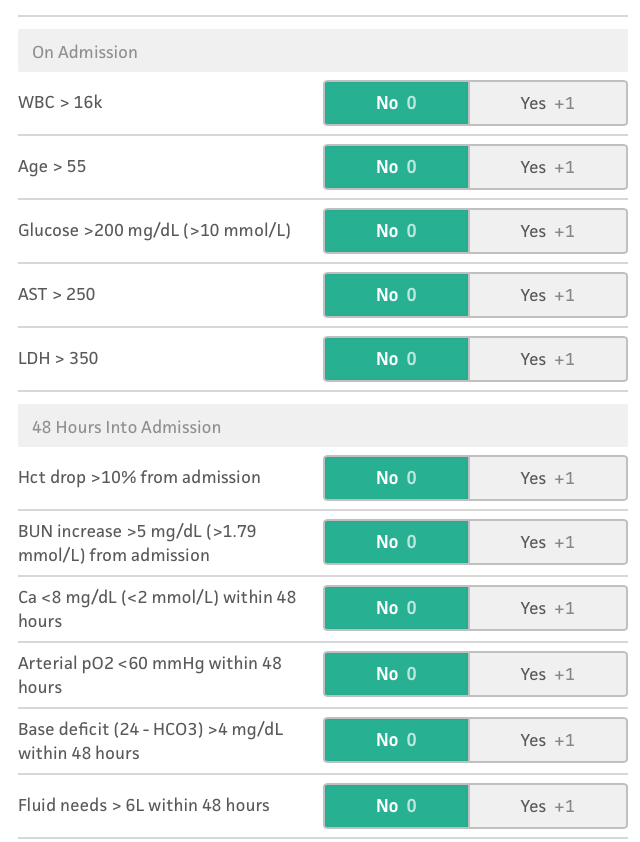
The BISAP score was developed in 2008 from a retrospective analysis of a large patient database and then validated from analysis of a later data set (Wu, 2008). This score has several advantages including that the data set used included approximately 18000 cases of acute pancreatitis for the derivation and also for the validation. There are fewer variables in the score, making it more user friendly than the APACHE II and Ranson Criteria. The validation compared performance with the bulkier APACHE II and performed similarly in predicting mortality (Wu, 2008). This scoring system was originally developed to use after the first 24 hours of hospital admission but is often used in the ED to risk stratify patients.

The APACHE II score was developed in 1985 as a simpler solution to APACHE I (Knaus, 1985). The authors consolidated the original 32 variables into 12 and predicted mortality based on these variables at 24 hours of ICU admission. The APACHE II was designed to be used for both mortality prediction and research purposes. Of note, the authors noted that mental status and renal function were important predictors in mortality. They weighted GCS more heavily and lowered the threshold for decreased renal function to represent their contribution to mortality. The score does use PaO2 or A-a gradient, which is not usually readily available (Knaus, 1985).
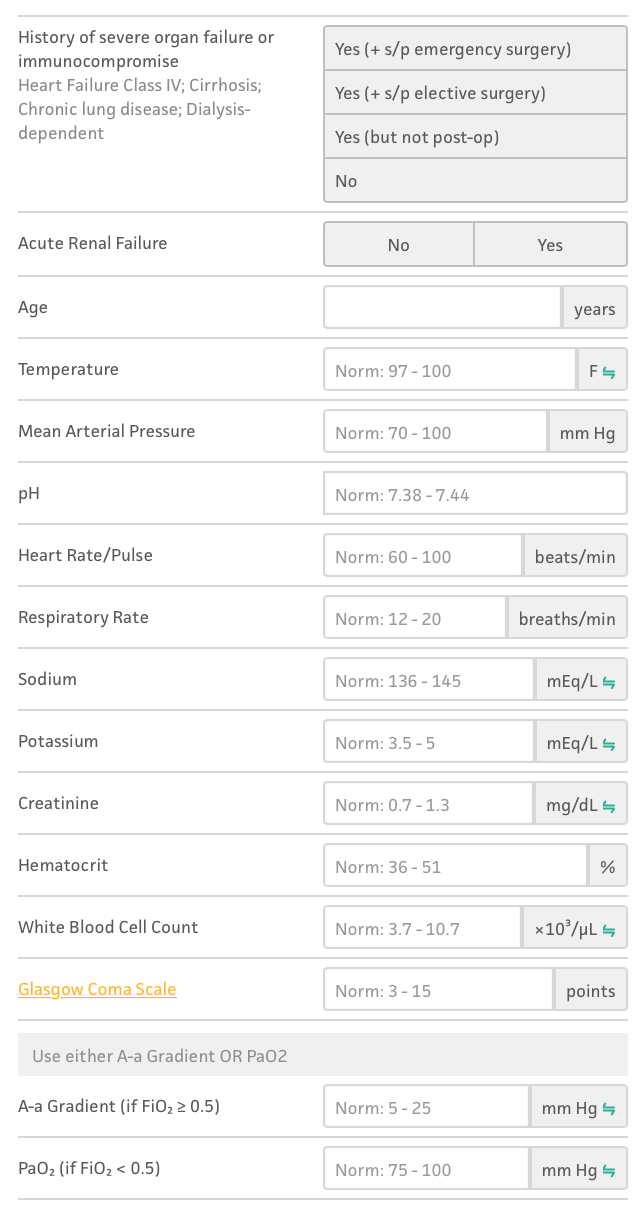
In a cohort of 87 patients in an Australian ED, it was found that the “BISAP score surpasses Ranson’s and Acute Physiological and Chronic Health Examination (APACHE) II scores in discriminating between survivors and non-survivors among unselected patients with acute pancreatitis admitted to ICU, whereas APACHE II discriminates better in the cohort admitted from ED.” (Sundararajan, 2017). Most of the prediction models were developed for use in the hospital floor or ICU setting, and there is a paucity of data evaluating these clinical prediction scores in the ED. A 2016 review of 94 articles evaluating 18 different clinical prediction tools revealed high variability among the patient characteristics in each individual study and rates of mortality. APACHE II and Ranson were the most frequently cited, and APACHE II was found to be more sensitive than the Ranson criteria (Di, 2016).
Overall, the APACHE II and BISAP scores are the most useful prediction models for ED use due to increased sensitivity and the availability of data. Keep in mind that age, comorbidities, and vital sign abnormalities are not present in all the scoring systems but play a key role in risk stratification in the ED.
Who to discharge?
Not only have there been few studies evaluating the use of prediction models in the ED setting, even fewer evaluate the possibility of using these models or others to safely discharge a patient from the ED without observation. Discharge criteria are based on general criteria for patients with any GI complaint and common clinical practice.
Criteria for who may be discharged from the ED include normal vital signs after pain management and fluid resuscitation; pain controlled by oral medication; ability to tolerate oral intake; no evidence of end-organ damage; ability to follow up; and absence of significant comorbidities such as uncontrolled diabetes mellitus, immunosuppression, and extremes of age. Patients with a high predicted mortality based on any of the predictive scores and those with gallstone pancreatitis requiring surgical or GI intervention should not be discharged from the ED (Besinger, 2016).
Follow up with a gastroenterologist is especially important for those patients who are discharged without an identified cause of their disease. Pancreatic and pancreatic duct cancers will need further investigation in patients over the age of 40.
Key Points
- Diagnosis of pancreatitis: 2 out of 3 criteria met => upper abdominal pain (clinical), serum lipase or amylase >3x upper limit of normal (laboratory), or imaging findings of pancreatic inflammation.
- CT is not necessary if diagnosis can be made without it and is better obtained later in the disease course if needed.
- Patients should receive a RUQ US in the ED if it will impact management.
- Be cautious and avoid normal saline for fluid resuscitation (Lactated Ringer’s likely best).
- APACHE II and BISAP score are the most useful predictors of mortality in the ED, but keep the entire clinical picture in mind.
- There is little research to support discharging patients from the ED, but it may be possible in specific circumstances.
For more on pancreatitis, see these great pieces from Dr. Katy Hanson at www.hansonsanatomy.com
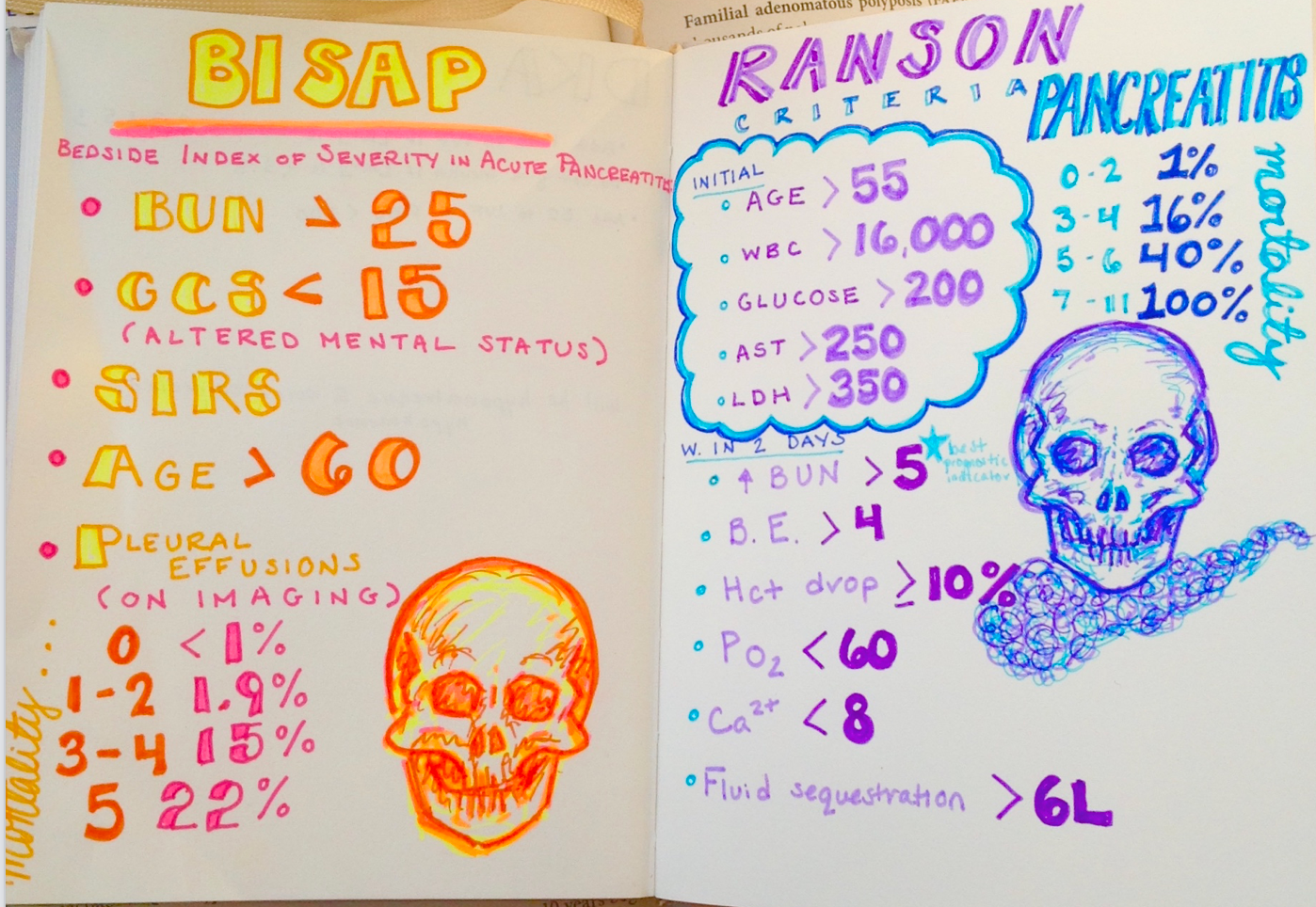
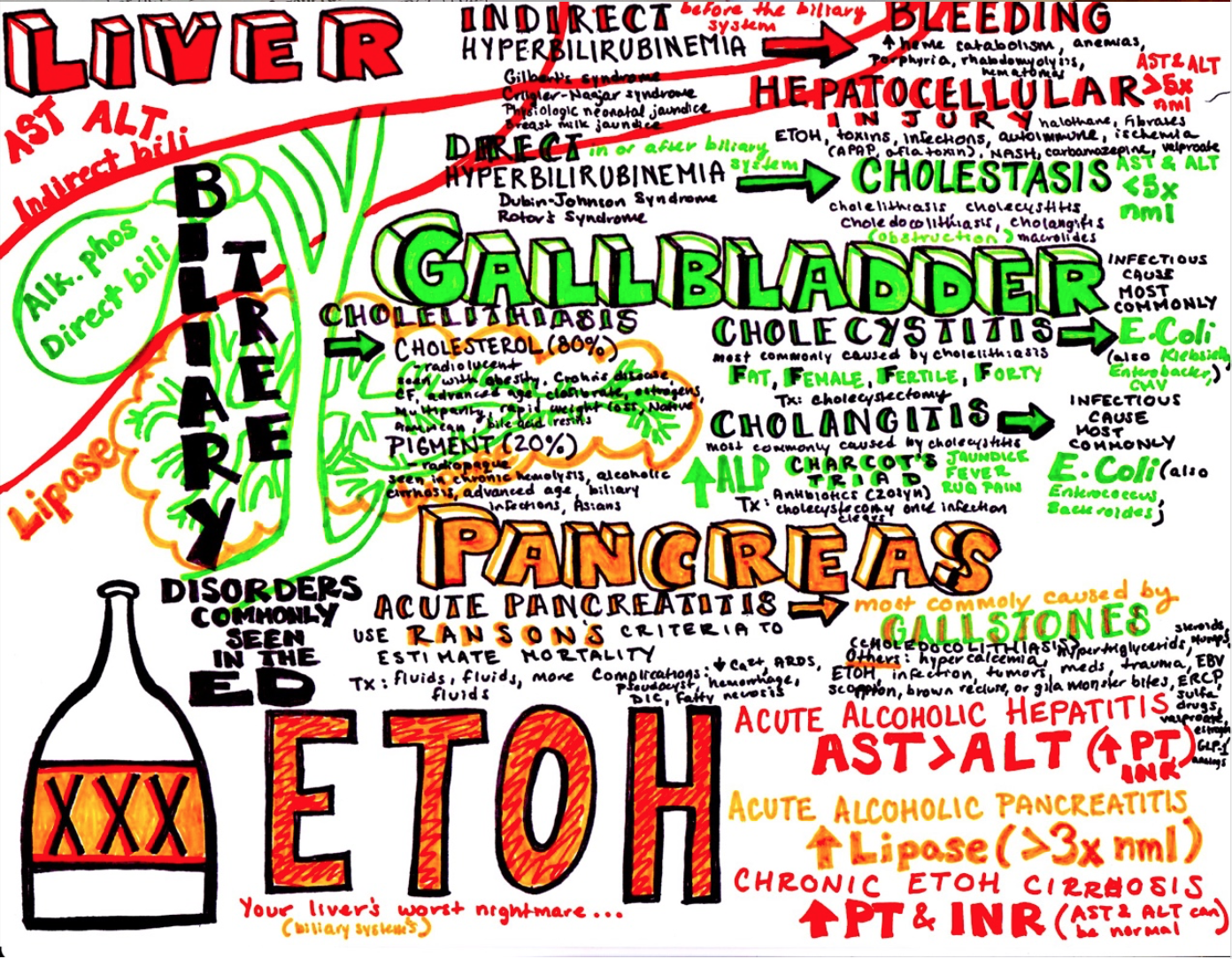
References/Further Reading
- Tenner S, Baillie J, DeWitt J, Vege SS. American College of Gastroenterology guideline: management of acute pancreatitis. The American journal of gastroenterology. 2013;108:1400-1415; 1416.
- Wang GJ, Gao CF, Wei D, Wang C, Ding SQ. Acute pancreatitis: etiology and common pathogenesis. World journal of gastroenterology. 2009;15:1427-1430.
- Cheng CL, Sherman S, Watkins JL, et al. Risk factors for post-ERCP pancreatitis: a prospective multicenter study. The American journal of gastroenterology. 2006;101:139-147.
- Gorelick FS. Alcohol and zymogen activation in the pancreatic acinar cell. 2003;27:305-310.
- Ewald N, Hardt PD, Kloer HU. Severe hypertriglyceridemia and pancreatitis: presentation and management. Current opinion in lipidology. 2009;20:497-504.
- Hammond DA, Finlay L. Treatment of Hypertriglyceridemia-Induced Acute Pancreatitis With Insulin, Heparin, and Gemfibrozil: A Case Series. Hospital pharmacy. 2017;52:675-678.
- Besinger B, Stehman CR. Pancreatitis and Cholecystitis. In: Tintinalli JE, Stapczynski JS, Ma OJ, Yealy DM, Meckler GD, Cline DM, eds. Tintinalli’s Emergency Medicine: A Comprehensive Study Guide, 8e. New York, NY: McGraw-Hill Education; 2016.
- Pandol SJ, Saluja AK, Imrie CW, Banks PA. Acute pancreatitis: bench to the bedside. 2007;132:1127-1151.
- IAP/APA evidence-based guidelines for the management of acute pancreatitis. Pancreatology: official journal of the International Association of Pancreatology (IAP) … [et al.]. 2013;13:e1-15.
- Zaheer A, Singh VK, Qureshi RO, Fishman EK. The revised Atlanta classification for acute pancreatitis: updates in imaging terminology and guidelines. Abdominal imaging. 2013;38:125-136.
- Rompianesi G, Hann A, Komolafe O, Pereira SP, Davidson BR, Gurusamy KS. Serum amylase and lipase and urinary trypsinogen and amylase for diagnosis of acute pancreatitis. The Cochrane database of systematic reviews. 2017;4:CD012010.
- Bokemeyer B. Asymptomatic elevation of serum lipase and amylase in conjunction with Crohn’s disease and ulcerative colitis. Zeitschrift fur Gastroenterologie. 2002;40:5-10.
- Yadav D, Nair S, Norkus EP, Pitchumoni CS. Nonspecific hyperamylasemia and hyperlipasemia in diabetic ketoacidosis: incidence and correlation with biochemical abnormalities. The American journal of gastroenterology. 2000;95:3123-3128.
- Liu KJ, Atten MJ, Lichtor T, et al. Serum amylase and lipase elevation is associated with intracranial events. The American surgeon. 2001;67:215-219; discussion 219-220.
- Gumaste VV, Roditis N, Mehta D, Dave PB. Serum lipase levels in nonpancreatic abdominal pain versus acute pancreatitis. The American journal of gastroenterology. 1993;88:2051-2055.
- Chen YT, Chen CC, Wang SS, Chang FY, Lee SD. Rapid urinary trypsinogen-2 test strip in the diagnosis of acute pancreatitis. 2005;30:243-247.
- Gurusamy KS, Davidson C, Gluud C, Davidson BR. Early versus delayed laparoscopic cholecystectomy for people with acute cholecystitis. The Cochrane database of systematic reviews. 2013:CD005440.
- Balthazar EJ, Robinson DL, Megibow AJ, Ranson JH. Acute pancreatitis: value of CT in establishing prognosis. 1990;174:331-336.
- Gardner TB, Vege SS, Pearson RK, Chari ST. Fluid resuscitation in acute pancreatitis. Clinical gastroenterology and hepatology : the official clinical practice journal of the American Gastroenterological Association. 2008;6:1070-1076.
- Brown A, Baillargeon JD, Hughes MD, Banks PA. Can fluid resuscitation prevent pancreatic necrosis in severe acute pancreatitis? Pancreatology : official journal of the International Association of Pancreatology (IAP) … [et al.]. 2002;2:104-107.
- Knoefel WT, Kollias N, Warshaw AL, Waldner H, Nishioka NS, Rattner DW. Pancreatic microcirculatory changes in experimental pancreatitis of graded severity in the rat. 1994;116:904-913.
- Strate T, Mann O, Kleinhans H, et al. Microcirculatory function and tissue damage is improved after therapeutic injection of bovine hemoglobin in severe acute rodent pancreatitis. 2005;30:254-259.
- Buxbaum JL, Quezada M, Da B, et al. Early Aggressive Hydration Hastens Clinical Improvement in Mild Acute Pancreatitis. The American journal of gastroenterology. 2017;112:797-803.
- Mao EQ, Tang YQ, Fei J, et al. Fluid therapy for severe acute pancreatitis in acute response stage. Chinese medical journal. 2009;122:169-173.
- Mao EQ, Fei J, Peng YB, Huang J, Tang YQ, Zhang SD. Rapid hemodilution is associated with increased sepsis and mortality among patients with severe acute pancreatitis. Chinese medical journal. 2010;123:1639-1644.
- Farkas J. The Myth of Large-Volume resuscitation in Acute Pancreatitis. Vol 20218. PULMCrit2014.
- de-Madaria E, Soler-Sala G, Sanchez-Paya J, et al. Influence of fluid therapy on the prognosis of acute pancreatitis: a prospective cohort study. The American journal of gastroenterology. 2011;106:1843-1850.
- Khajavi MR, Etezadi F, Moharari RS, et al. Effects of normal saline vs. lactated ringer’s during renal transplantation. Renal failure. 2008;30:535-539.
- Todd SR, Malinoski D, Muller PJ, Schreiber MA. Lactated Ringer’s is superior to normal saline in the resuscitation of uncontrolled hemorrhagic shock. The Journal of trauma. 2007;62:636-639.
- Seyama Y, Otani T, Matsukura A, Makuuchi M. The pH modulator chloroquine blocks trypsinogen activation peptide generation in cerulein-induced pancreatitis. 2003;26:15-17.
- Wu BU, Hwang JQ, Gardner TH, et al. Lactated Ringer’s solution reduces systemic inflammation compared with saline in patients with acute pancreatitis. Clinical gastroenterology and hepatology : the official clinical practice journal of the American Gastroenterological Association. 2011;9:710-717 e711.
- Singh VK, Wu BU, Bollen TL, et al. Early systemic inflammatory response syndrome is associated with severe acute pancreatitis. Clinical gastroenterology and hepatology : the official clinical practice journal of the American Gastroenterological Association. 2009;7:1247-1251.
- Mofidi R, Duff MD, Wigmore SJ, Madhavan KK, Garden OJ, Parks RW. Association between early systemic inflammatory response, severity of multiorgan dysfunction and death in acute pancreatitis. The British journal of surgery. 2006;93:738-744.
- Forsmark CE, Baillie J. AGA Institute technical review on acute pancreatitis. 2007;132:2022-2044.
- Petrov MS, McIlroy K, Grayson L, Phillips AR, Windsor JA. Early nasogastric tube feeding versus nil per os in mild to moderate acute pancreatitis: a randomized controlled trial. Clinical nutrition (Edinburgh, Scotland). 2013;32:697-703.
- Li JY, Yu T, Chen GC, et al. Enteral nutrition within 48 hours of admission improves clinical outcomes of acute pancreatitis by reducing complications: a meta-analysis. PloS one. 2013;8:e64926.
- Ellery KM, Kumar S, Crandall W, Gariepy C. The Benefits of Early Oral Nutrition in Mild Acute Pancreatitis. The Journal of pediatrics. 2017;191:164-169.
- Ranson JH, Rifkind KM, Roses DF, Fink SD, Eng K, Spencer FC. Prognostic signs and the role of operative management in acute pancreatitis. Surgery, gynecology & obstetrics. 1974;139:69-81.
- Wu BU, Johannes RS, Sun X, Tabak Y, Conwell DL, Banks PA. The early prediction of mortality in acute pancreatitis: a large population-based study. 2008;57:1698-1703.
- Knaus WA, Draper EA, Wagner DP, Zimmerman JE. APACHE II: a severity of disease classification system. Critical care medicine. 1985;13:818-829.
- Sundararajan K, Schoeman T, Hughes L, Edwards S, Reddi B. Predictors and outcomes of acute pancreatitis in critically ill patients presenting to the emergency department of a tertiary referral centre in Australia. Emergency medicine Australasia : EMA. 2017;29:184-191.
- Di MY, Liu H, Yang ZY, Bonis PA, Tang JL, Lau J. Prediction Models of Mortality in Acute Pancreatitis in Adults: A Systematic Review. Annals of internal medicine. 2016;165:482-490.






